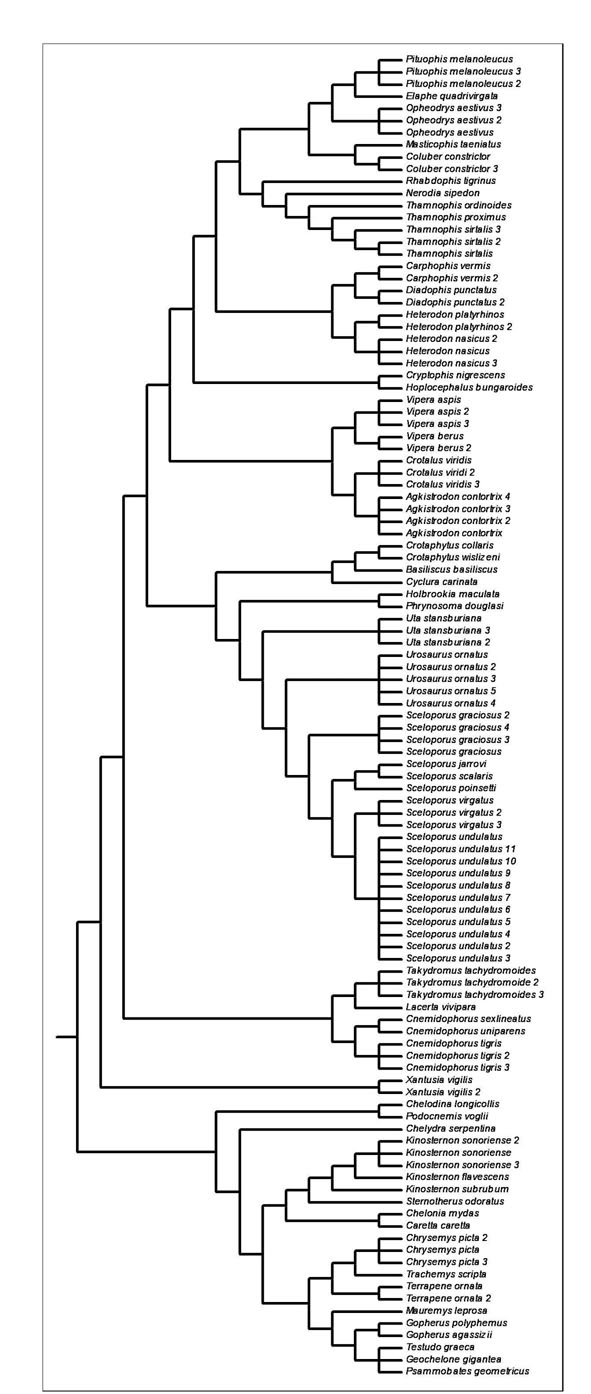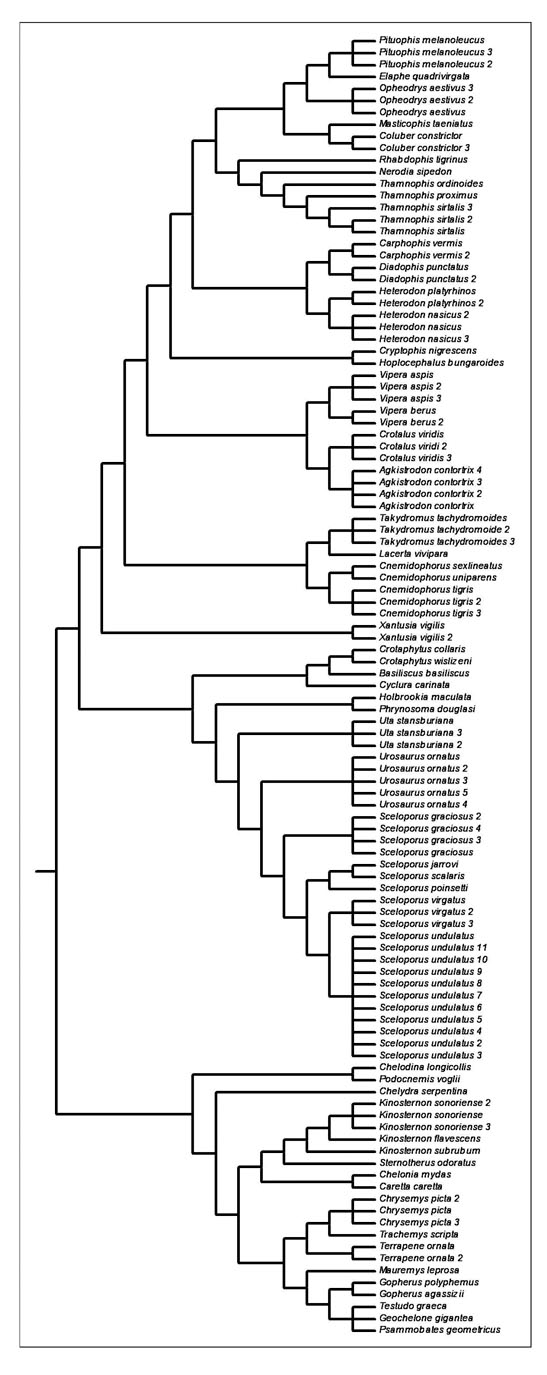

Appendix C. Phylogenetic hypotheses for relationships among the reptile taxa we studied, based on the following literature: (1) lizards: Reeder and Wiens, 1996; Wiens and Reeder, 1997; Reeder et al., 2002; Schulte et al., 2003, (2) snakes: Knight et al., 1992; Heise et al., 1995; Rodrígues-Robles and Jesús-Escobar, 1999; Parkinson, 1999, Parkinson et al., 2002; Vidal et al., 1999, 2000; Murphy et al., 2002; Vorris et al., 2002; Utiger et al., 2002; Kelly et al., 2003; Garrigues et al., 2005; Lawson et al., 2005, and (3) turtles: Gaffney and Meylan, 1988; Lamb and Lydeard, 1994; Shaffer et al., 1997; Stephens and Wiens, 2003; Fujita et al., 2004). Numbers next to species names indicate different populations.

|

|
LITERATURE CITED
Fujita, M. K., T. N. Engstrom, D. E. Starkey, and H. B. Shaffer. 2004. Turtle phylogeny: insights from a novel nuclear intron. Molecular Phylogenetics and Evolution 31:1031–1040.
Gaffney, E. S., and P. A. Meylan. 1988. A phylogeny of turtles. Pages 157–219 in M. J. Benton, Editor. The Phylogeny and Classification of the Tetrapods, vol. 1. Clarendon Press, Oxford, UK.
Garrigues, T., C. Dauga, E. Ferquel, V. Choumet, and A. B. Failloux. 2005. Molecular phylogeny of Vipera Laurenti, 1968 and the related genera Macrovipera (Reuss, 1927), with comments about neurotoxic Vipera aspis aspis populations. Molecular Phylogenetics and Evolution 35:35–47.
Heise, P. J, L. R. Maxson, H. G. Dowling, and S. B. Hedges. 1995. High-level snake phylogeny inferred from mitochondrial DNA sequences of 12S rRNA and 16S rRNA genes. Molecular Biology and Evolution 12:259–265.
Kelly, C. M. R., P. N. Barker, and M. H. Villet. 2003. Phylogenetics of advanced snakes (Caenophidia) based on four mitochondrial genes. Systematic Biology 52:439–459.
Knight, A., L. D. Densmore, and E. D. Rael. 1992. Molecular systematics of the Agkistrodon complex. Pages 49-70 in Campbell, J. A., and E. D. Brodie Jr., eds. Biology of the Pitvipers. Selva, Tyler Texas USA.
Lamb, T., and C. Lydeard. 1994. A molecular phylogeny of the gopher tortoises, with comments on familial relationships within the Testudinoidea. Molecular Phylogenetics and Evolution 3:283–291.
Lawson, R., J. B. Slowinski, B. I. Crother, and F. T. Burbrink. 2005. Phylogeny of the Colubroidea (Serpentes): new evidence from mitochondrial and nuclear genes. Molecular Phylogenetics and Evolution 37:581–601.
Murphy, R. W., J. Fu, A. Lathrop, J. V. Feltham, and V. Kovac. 2002. Phylogeny of the rattlesnakes (Crotalus and Sistrurus) inferred from sequences of five mitochondrial genes. Pages 69–72 in Schuett, G. W., M. Höggren, M. E. Douglas, and H. W. Greene, eds. Biology of the Vipers. Eagle Mountain Publishing, Salt Lake City Utah USA.
Parkinson, C. L. 1999. Molecular systematics and biogeographical history of pitvipers as determined by mitochondrial ribosomal DNA sequences. Copeia 1999:576–586.
Parkinson, C. L., J. A. Campbell, and P. T. Chippindale. 2002. Multigene phylogenetic analyses of pitvipers; with comments on the biogeographical history of the group. Pages 93–110 in Schuett, G. W., M. Höggren, M. E. Douglas, and H. W. Greene, eds. Biology of the Vipers. Eagle Mountain Publishing, Salt Lake City Utah USA.
Reeder, T. W., and J. J. Wiens. 1996. Evolution of the lizard family Phrynostomatidade as inferred from diverse types of data. Herpetological Monographs 10:43–84.
Reeder, T. W, C. J. Cole, and H. C. Dessauer. 2002. Phylogenetic relationships of whiptail lizards of the genus Cnemidophorus (Squamata: Teiidae): a test of monophyly, reevaluation of karyotypic evolution, and a review of hybrid origins. American Museum Novitates 3365:1–61.
Rodrígues-Robles, J., and J. M. Jesús-Escobar. 1999. Molecular systematics of New World lampropeltine snakes (Colubridade): implications for biogeography and evolution of food habits. Biological Journal of the Linnean Society 68:355–385.
Schulte, J. A. II, J. P. Valladares, and A. Larson. 2003. Phylogenetic relationships within Iguanidae inferred using molecular and morphological data and a phylogenetic taxonomy of iguanian lizards. Herpetologica 59:399–419.
Shaffer, H. B., P. Meylan, and M. L. McKnight. 1997. Tests of turtle phylogeny: molecular, morphological, and paleontological approaches. Systematic Biology 46:235–268.
Stephens, P. R., and J. J. Wiens. 2003. Ecological diversification and phylogeny of emydid turtles. Biological Journal of the Linnean Society 79:577–610.
Utiger, U., N. Helfenberger, B. Schätti, C. Schmidt, M. Ruf, and V. Ziswiler. 2002. Molecular systematics and phylogeny of Old and New World ratsnakes, Elaphe Auct., and related genera (Reptilia, Squamata, Colubridae). Russian Journal of Herpetology 9:105–124.
Vidal, N., and S. B. Hedges. 2005. The phylogeny of squamate reptiles (lizards, snakes, and amphisbaenians) inferred from nine nuclear protein-coding genes. Comptes Rendus Biologies 328:1000–1008.
Vidal, N., S. G. Kindl, A. Wong, and S. B. Hedges. 2000. Phylogenetic relationships of Xenodontinae snakes inferred from 12S and 16S ribosomal RNA sequences. Molecular Phylogenetics and Evolution 14:389–402.
Vidal, N., G. Lecointre, J. C. Vié, and J. P. Gasc. 1999. What can mitochondrial gene sequences tell us about intergeneric relationships of pitvipers? Kaupia 8:113–126.
Vorris, H., M. E. Alfaro, D. R. Karns, G. L. Starnes, E. Thompson, and J. C. Murphy. 2002. Phylogenetic relationships of the Oriental-Australian rear-fanged water snakes (Colubridae: Homalopsinae) based on mitochondrial DNA sequences. Copeia 2002:906–915.
Wiens, J. J., and T. W. Reeder. 1997. Phylogeny of the spiny lizards (Sceloporus) based on molecular and morphological evidence. Herpetological Monographs 11:1–101.